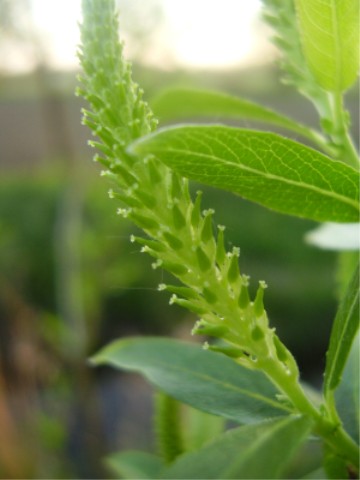- Salix triandra
Taxobox
name = "Salix triandra"
status =

image_width = 240px
image_caption = Leaves and female catkin
regnum =Plant ae
divisio = Magnoliophyta
classis = Magnoliopsida
ordo =Malpighiales
familia =Salicaceae
genus = "Salix"
species = "S. triandra"
binomial = "Salix triandra"
binomial_authority = L."Salix triandra" (Almond Willow or Almond-leaved Willow) is a species of
willow native toEurope and western and centralAsia , from southeasternEngland east toLake Baikal , and south toSpain and theCaucasus andAlborz mountains. It usually grows on river banks andwetland s.Meikle, R. D. (1984). "Willows and Poplars of Great Britain and Ireland". BSBI Handbook No. 4. ISBN 0-901158-07-0.] Rushforth, K. (1999). "Trees of Britain and Europe". Collins ISBN 0-00-220013-9.] Den Virtuella Floran: [http://linnaeus.nrm.se/flora/di/salica/salix/salitri.html "Salix triandra" (in Swedish; with maps)] ]It is a
deciduous shrub or smalltree growing to 10 m tall, usually multistemmed, with an irregular, often leaning crown. Thebark is smooth grey-brown at first, becoming scaly on older stems with large scales exfoliating (like a plane tree) to leave orange-brown patches. The leaves are broad lanceolate, 4-11 cm long and 1-3 cm wide, with a serrated margin; they are dull dark green above and green to glaucous-green below, with a 1–2 cm petiole with two conspicuous basalstipule s. Theflower s are produced incatkin s in early spring at the same time as the new leaves, and pollinated byinsect s. They are dioecious, with male and female catkins on separate trees; the male catkins are 2.5–8 cm long, the female catkins 2–4 cm long. The male flowers have threestamen s, a useful identification feature with most other willows having two or five stamens.The variety "Salix triandra" var. "hoffmanniana" Bab., found in
Great Britain , is distinguished by being smaller (rarely over 4 m tall) and densely branched, with smaller leaves 2-7 cm long and 1-2.5 cm wide not glaucous below. It is not considered distinct by all authorities, particularly on continental Europe, so its range outside Britain, if any, is not reported.The scientific name derives from the male flowers having three stamens. The English name refers to the similarity in leaf shape to
Almond leaves.It readily forms natural hybrids with "
Salix viminalis ", the hybrid being named "Salix × mollissima" Hoffm. ex Elwert.Plants from eastern Asia formerly treated as "Salix triandra" var. "nipponica" (Franch. & Savatier) Seem. are now considered a distinct species "
Salix nipponica "; it shares the feature of male flowers with three stamens.Flora of China: [http://www.efloras.org/florataxon.aspx?flora_id=2&taxon_id=210001955 "Salix nipponica"] ] InNorth America , it is replaced by the related "Salix amygdaloides " (Peachleaf Willow), which differs in having male flowers with 4–7 stamens.Northern Prairie Wildlife Research Center: [http://www.npwrc.usgs.gov/resource/plants/vascplnt/species/samy.htm "Salix amygdaloides"] ]Cultivation and uses
The shoots (withies) are extensively used for basket-making; it is one of the most important willows for this purpose after "
Salix viminalis ", with several selectedcultivar s including 'Black Maul', 'Grizette', 'Mottled Spaniards', 'Sarda', and 'Yellow Dutch'.References
Wikimedia Foundation. 2010.
